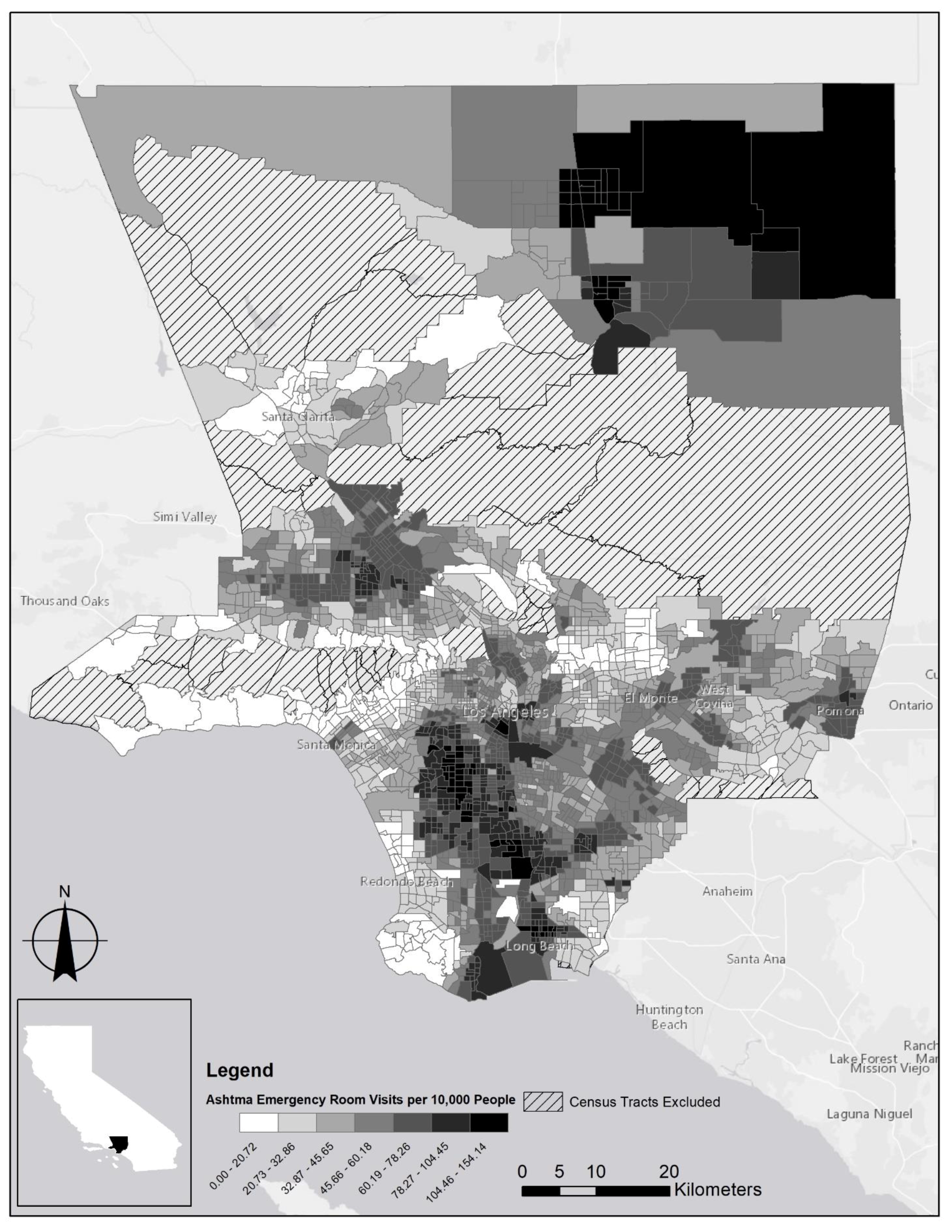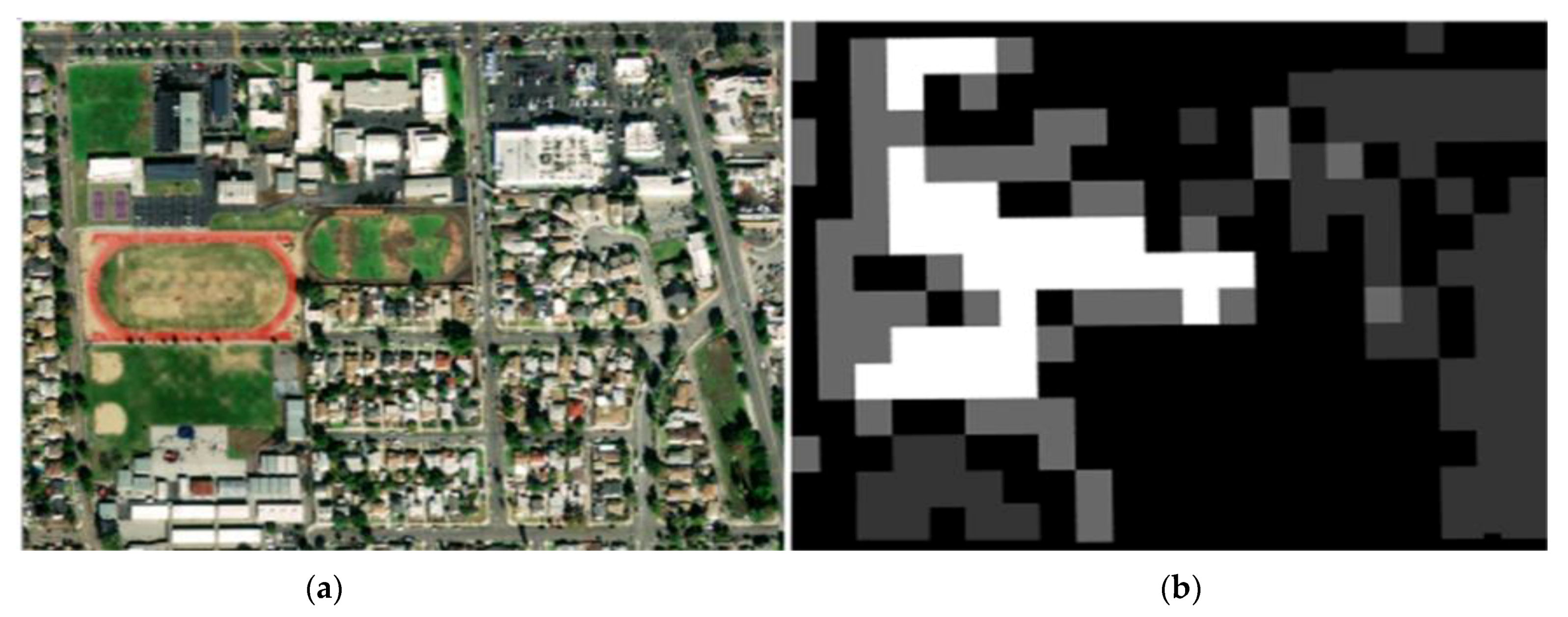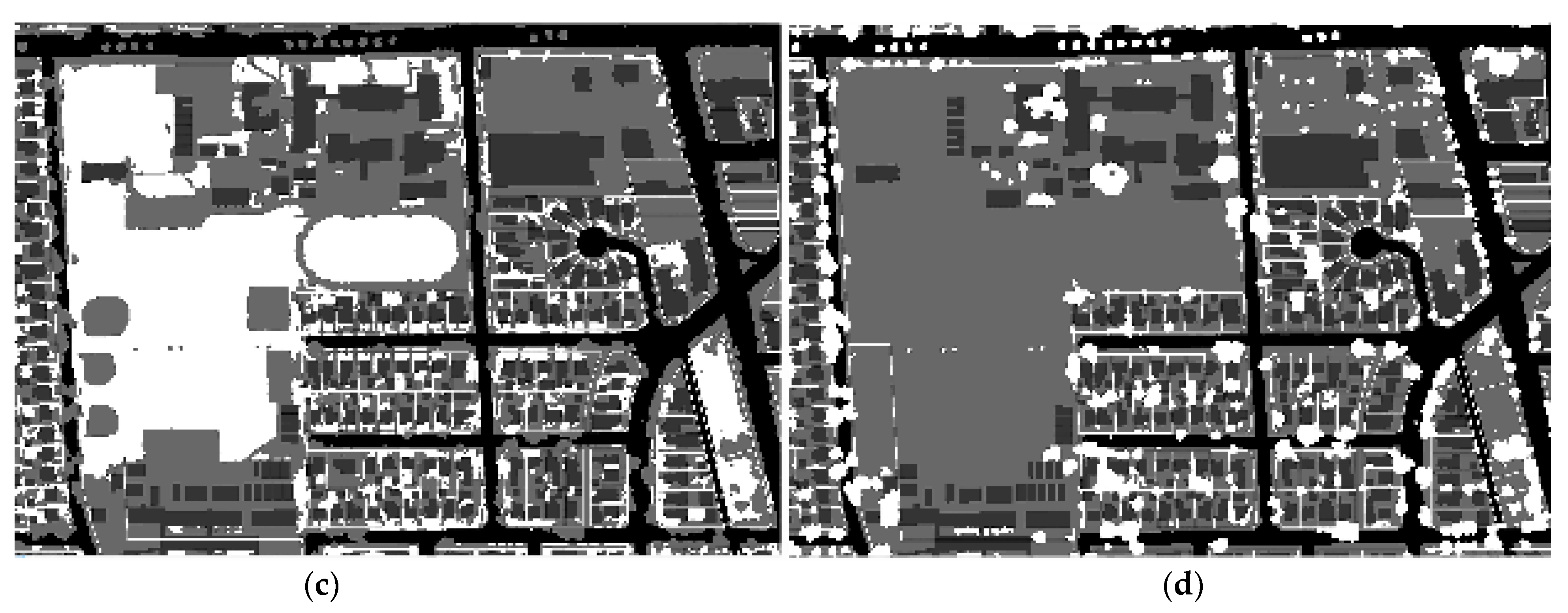The Contribution of Neighborhood Tree and Greenspace to Asthma Emergency Room Visits: An Application of Advanced Spatial Data in Los Angeles County
Abstract
1. Introduction
2. Methodology
- y = a vector of observations on the dependent variable;
- Wy = a spatially lagged dependent variable for the weight matrix, W;
- X = a matrix of observations on the explanatory variables;
- ε = a vector of error terms;
- p, β = parameters.
- y = a vector of observations on the dependent variable;
- W = the spatial weight matrix;
- X = a matrix of observations on the explanatory variables;
- ε = a vector of spatially autocorrelated error terms;
- u = a vector of errors;
- λ, β = parameters.
3. Analysis and Findings
4. Discussion
5. Conclusions
Author Contributions
Funding
Institutional Review Board Statement
Informed Consent Statement
Data Availability Statement
Conflicts of Interest
References
- Hsu, J.; Sircar, K.; Herman, E.; Garbe, P. Exhale: A Technical Package to Control Asthma; Center for Disease Control and Prevention (CDC): Atlanta, GA, USA, 2018.
- Peden, D. The epidemiology and genetics of asthma risk associated with air pollution. J. Allergy Clin. Immunol. 2005, 115, 213–219. [Google Scholar] [CrossRef] [PubMed]
- Markevych, I.; Tesch, F.; Datzmann, T.; Romanos, M.; Schmitt, J.; Heinrich, J. Outdoor air pollution, greenspace, and incidence of ADHD: A semi-individual study. Sci. Total Environ. 2018, 642, 1362–1368. [Google Scholar] [CrossRef] [PubMed]
- Selmi, W.; Weber, C.; Riviere, E.; Blond, N.; Mehdi, L.; Nowak, D. Air pollution removal by trees in public green spaces in Strasbourg city, France. Urban For. Urban Green. 2016, 17, 192–201. [Google Scholar] [CrossRef]
- Wolch, J.R.; Byrne, J.; Newell, J.P. Urban green space, public health, and environmental justice: The challenge of making cities? Just green enough? Landsc. Urban Plan. 2014, 125, 234–244. [Google Scholar] [CrossRef]
- Yang, J.; McBride, J.; Zhou, J.; Sun, Z. The urban forest in Beijing and its role in air pollution reduction. Urban For. Urban Green. 2005, 3, 65–78. [Google Scholar] [CrossRef]
- De Ridder, K.; Adamec, V.; Banuelos, A.; Bruse, M.; Burger, M.; Damsgaard, O.; Dufek, J.; Hirsch, J.; Lefebre, F.; Perez-Lacorzana, J.M. An integrated methodology to assess the benefits of urban green space. Sci. Total Environ. 2004, 334, 489–497. [Google Scholar] [CrossRef]
- Alcock, I.; White, M.; Cherrie, M.; Wheeler, B.; Taylor, J.; McInnes, R.; Kampe, E.O.; Vardoulakis, S.; Sarran, C.; Soyiri, I. Land Cover and Air Pollution Are Associated with Asthma Hospitalisations: A Cross-Sectional Study. Environment International; Elsevier: Amsterdam, The Netherlands, 2017; pp. 29–41. [Google Scholar]
- Feng, X.; Astell-Burt, T. Is neighborhood green space protective against associations between child asthma, neighborhood traffic volume and perceived lack of area safety? Multilevel analysis of 4447 Australian children. Int. J. Environ. Res. Public Health 2017, 14, 543. [Google Scholar] [CrossRef]
- Lovasi, G.S.; Quinn, J.W.; Neckerman, K.M.; Perzanowski, M.S.; Rundle, A. Children living in areas with more street trees have lower prevalence of asthma. Epidemiol. Community Health 2008, 62, 647–649. [Google Scholar] [CrossRef]
- Lovasi, G.S.; O’Neil-Dunne, J.P.M.; Lu, J.W.T.; Sheehan, D.; Perzanowski, M.S.; MacFaden, S.W.; King, K.L.; Matte, T.; Miller, R.; Hoepner, A. Urban tree canopy and asthma, wheeze, rhinitis, and allergic sensitization to tree pollen in a New York City birth cohort. Environ. Health Perspect. 2013, 121, 494–500. [Google Scholar] [CrossRef]
- Andrusaityte, S.; Grazuleviciene, R.; Kudzyte, J.; Bernotiene, A.; Dedele, A.; Nieuwenhuijsen, M.J. Associations between Neighbourhood Greenness and Asthma in Preschool Children in Kaunas, Lithuania: A Case-Control Study. BMJ Open 2016, 6, e010341. [Google Scholar] [CrossRef]
- Dadvand, P.; Villanueva, C.M.; Font-Ribera, L.; Martinez, D.; Basagana, X.; Belmonte, J.; Vrijheid, M.; Grazuleviciene, R.; Kogevinas, M.; Nieuwenhuijsen, M.J. Risks and benefits of green spaces for children: A cross-sectional study of associations with sedentary behavior, obesity, asthma, and allergy. Environ. Health Perspect. 2014, 122, 1329–1335. [Google Scholar] [CrossRef] [PubMed]
- Zandbergen, P.A. Methodological issues in determining the relationship between street trees and asthma prevalence. J. Epidemiol. Community Health 2009, 63, 174–175. [Google Scholar] [CrossRef]
- Zhou, X.; Kim, J. Social disparities in tree canopy and park accessibility: A case study of six cities in Illinois using GIS and remote sensing. Urban For. Urban Green. 2013, 12, 88–97. [Google Scholar] [CrossRef]
- California Environmental Protection Agency (CalEPA) and Office of Environmental Health Hazard Assessment (OEHHA). CalEnvirScreen 3.0; California Environmental Protection Agency (CalEPA) and Office of Environmental Health Hazard Assessment (OEHHA): Sacramento, CA, USA, 2017.
- Mar, T.F.; Koenig, J.Q.; Primomo, J. Associations between asthma emergency visits and particulate matter sources, including diesel emissions from stationary generators in Tacoma, Washington. Inhal. Toxicol. 2010, 22, 445–448. [Google Scholar] [CrossRef] [PubMed]
- Stieb, D.M.; Burnett, R.T.; Beveridge, R.C.; Brook, J.R. Association between ozone and asthma emergency department visits in Saint John, New Brunswick, Canada. Environ. Health Perspect. 1996, 104, 1354–1360. [Google Scholar] [CrossRef]
- Villeneuve, P.J.; Leech, J.; Bourque, D. Frequency of emergency room visits for childhood asthma in Ottawa, Canada: The role of weather. Int. J. Biometeorol. 2005, 50, 48–56. [Google Scholar] [CrossRef]
- Mohr, L.B.; Luo, S.; Mathias, E.; Tobing, R.; Homan, S.; Sterling, D. Influence of season and temperature on the relationship of elemental carbon air pollution to pediatric asthma emergency room visits. J. Asthma 2008, 45, 936–943. [Google Scholar] [CrossRef] [PubMed]
- Kim, D.; Ahn, Y. Built Environment Factors Contribute to Asthma Morbidity in Older People: A Case Study of Seoul, Korea. J. Transp. Health 2018, 8, 91–99. [Google Scholar] [CrossRef]
- Ahn, Y.; Kim, D. The Prevalence of Asthma and Severe Asthma in Children Influenced by Transportation Factors: Evidence from Spatial Analysis in Seoul, Korea. Cities 2019, 85, 30–37. [Google Scholar] [CrossRef]
- Mitchell, A. The Esri Guide to GIS Analysis: Geographic Patterns and Relationships; ESRI, Inc.: Redland, CA, USA, 2020. [Google Scholar]
- Miller, J.E. The effects of race/ethnicity and income on early childhood asthma prevalence and health care use. Am. J. Public Health 2000, 90, 428–430. [Google Scholar] [CrossRef] [PubMed]
- Weiss, K.; Gergen, P.; Crain, E. Inner-city asthma: The epidemiology of an emerging US public health concern. Chest 1992, 101, S362–S367. [Google Scholar] [CrossRef]
- Cressie, N.A.C. Statistics for Spatial Data; John Wiley & Sons: New York, NY, USA, 1993. [Google Scholar]
- Ahn, Y.; Sohn, D. The effect of neighbourhood-level urban form on residential building energy use: A GIS-based model using building energy benchmarking data in Seattle. Energy Build. 2019, 196, 124–133. [Google Scholar] [CrossRef]
- Anselin, L. Spatial Econometrics: Methods and Models; Kluwer Academic: Dordrecht, The Netherlands, 1988. [Google Scholar]
- Judge, G.G.; Hill, R.C.; Griffiths, W.E. Introduction to the Theory and Practice of Econometrics; Wiley: New York, NY, USA, 1982. [Google Scholar]
- Wissow, L.S.; Gittelsohn, A.M.; Szklo, M.; Starfield, B.; Mussman, M. Poverty, race and hospitalization for childhood asthma. Am. J. Public Health 1998, 78, 777–782. [Google Scholar] [CrossRef] [PubMed]
- Kim, D. Transportation contributing factors to asthma morbidity: The case of Los Angeles County. Int. J. Urban Sci. 2019, 23, 16–29. [Google Scholar] [CrossRef]
- Ayres-Sampaio, D.; Teodoro, A.C.; Sillero, N.; Santos, C.; Fonseca, J.; Freitas, A. An investigation of the environmental determinants of asthma hospitalizations: An applied spatial approach. In Applied Geography; Elsevier: Amsterdam, The Netherlands, 2014; Volume 47, pp. 10–19. [Google Scholar]
- Erdman, E.; Liss, A.; Gute, D.; Rioux, C.; Koch, M.; Naumova, E. Does the presence of vegetation affect asthma hospitalizations among the elderly? A comparison between rural, suburban, and urban areas. Int. J. Environ. Sustain. 2015, 4, 1–14. [Google Scholar] [CrossRef]
- Pincetl, S. Implementing Municipal Tree Planting: Los Angeles Million-Tree Initiative. Environ. Manag. 2010, 45, 227–238. [Google Scholar] [CrossRef] [PubMed]
- McPherson, G.E.; Simpson, J.R.; Xiao, Q.; Wu, C. Los Angeles 1-Million Tree Canopy Cover Assessment; Technical Report. PSW-GTR-207; US Department of Agriculture, Forest Service, Pacific Southwest Research Station: Albany, CA, USA, 2008.
- California Environmental Protection Agency (CalEPA) and California Air Resources Board. Status of Research on Potential Mitigation Concepts to Reduce Exposure to Nearby Traffic Pollution; California Environmental Protection Agency (CalEPA) and California Air Resources Board: Sacramento, CA, USA, 2012.
- California Environmental Protection Agency (CalEPA) and California Air Resources Board. Air Quality and Land Use Handbook: A Community Health Perspective; California Environmental Protection Agency (CalEPA) and California Air Resources Board: Sacramento, CA, USA, 2005.
- Willson, R. Parking Management for Smart Growth; Island Press: Washington, DC, USA, 2015. [Google Scholar]



| Variables | Definitions | Descriptions | Sources |
|---|---|---|---|
| Dependent Variable | |||
| Asthma | The emergency department visits for asthma per 10,000 people by census tract (patients’ residential location basis, 3-year averages between 2011 and 2013) | CalEnviroScreen 3.0 | |
| Tree Variables | |||
| TreeCov | Areas covered by trees | The percent of census tract areas covered by tree canopy (%) | Los Angeles Regional Imagery Acquisition Consortium |
| TreeClus | The size of tree patch | The median size of the clustered tree patch (square feet) | |
| TreeAgr | Nearest neighbor index (NNI) | The level of cluster (or dispersion) of tree patches | |
| Green/Open Space Variables | |||
| PrvtGrn | Private urban greenspace | The percent of census tract areas occupied by garden/landscape space of urban land use types including residential, commercial, office, and industrial (%) | Los Angeles Regional Imagery Acquisition Consortium (LARIAC) |
| GrnRec | Greenspace in recreational areas | The percent of census tract areas occupied by greenspace, which is largely accessible by the public, including parks and recreational areas (%) | |
| SemiGrn | Semi-public greenspace | The percent of census tract areas occupied by greenspace, which is not accessible by the public, including golf courses, educational facilities, and cemeteries, as well as agricultural lands (%) | |
| Socio-Demographic Variables | |||
| PovRt | Poverty rate | The percent of households whose income in the past 12 months was below the poverty level (%) | The American Community Survey (2016; 5-year estimates) |
| EduAtn | Education attainment | The percent of population with high school degree or lower (%) | |
| EtnGrp | Ethnical background | The percent of the African American population (%) | |
| ChldPop | Children population | The percent of children population whose age is 10 or under (%) | |
| SnrPop | Elderly population | The percent of the elderly population whose age is 65 or above (%) | |
| Air Quality Variables | |||
| PM2.5 | Particulate matter 2.5 | The average of particulate matter 2.5 concentration from the years 2011 to 2013 | CalEnviroScreen 3.0 |
| Ozone | Level of ozone | The average daily maximum ozone concentration for the years 2011 to 2013 | |
| Variables | Minimum | Maximum | Mean | Std. Deviation | VIF |
|---|---|---|---|---|---|
| Asthma | 0.00 | 154.14 | 52.07 | 25.36 | - |
| Tree Variables | |||||
| TreeCov | 0.00 | 0.42 | 0.11 | 0.06 | 4.666 |
| TreeClus | 8.00 | 212.00 | 76.38 | 21.33 | 4.413 |
| TreeAgr | 0.20 | 1.14 | 0.81 | 0.15 | 1.088 |
| Open/Greenspace Variables | |||||
| PrvtGrn | 0.00 | 0.31 | 0.09 | 0.05 | 1.567 |
| GrnRec | 0.00 | 0.53 | 0.01 | 0.02 | 1.057 |
| SemiGrn | 0.00 | 0.85 | 0.01 | 0.04 | 1.046 |
| Socio-Demographic Variables | |||||
| PovRt | 0.00 | 100.00 | 18.82 | 13.01 | 1.395 |
| EduAtn | 0.00 | 100.00 | 1.79 | 21.90 | 1.013 |
| EtnGrp | 0.00 | 89.98 | 8.17 | 13.08 | 1.162 |
| ChldPop | 0.00 | 40.60 | 12.80 | 4.26 | 1.626 |
| SnrPop | 0.00 | 100.00 | 11.02 | 6.05 | 1.537 |
| Air Quality Variables | |||||
| PM2.5 | 5.34 | 12.89 | 11.53 | 1.28 | 1.726 |
| Ozone | 0.04 | 0.07 | 0.05 | 0.01 | 1.720 |
| Variables | SL Model | SE Model | OLS Model | |||||||
|---|---|---|---|---|---|---|---|---|---|---|
| Coef. | Standardized | S. E. | Z | Coef. | Standardized | S. E. | Z | Coef. | S. E. | |
| Constant | 7.586 | 24.613 | 6.376 | 1.190 | 48.153 | 50.304 | 15.520 | 3.103 | 52.075 | 0.375 |
| Tree Variables | ||||||||||
| TreeCov | −44.692 | −3.660 | 5.702 | *** −7.838 | −52.911 | −2.054 | 7.196 | *** −7.353 | −1.616 | 0.809 |
| TreeClus | −0.034 | −1.830 | 0.016 | ** −2.202 | −0.033 | −0.820 | 0.016 | ** −1.979 | −3.660 | 0.787 |
| TreeAgr | 15.687 | 1.616 | 2.693 | *** 5.824 | 15.232 | 2.138 | 2.908 | *** 5.238 | 0.309 | 0.397 |
| Open/Greenspace Variables | ||||||||||
| PrvtGrn | −12.998 | −1.232 | 6.954 | * −1.869 | 13.428 | 0.357 | 8.178 | 1.642 | −0.166 | 0.469 |
| GrnRec | 3.876 | 0.169 | 12.406 | 0.312 | 9.543 | 0.231 | 10.126 | 0.942 | 0.265 | 0.385 |
| SemiGrn | −1.567 | 0.033 | 7.267 | −0.216 | 1.014 | 0.031 | 5.971 | 0.170 | 0.183 | 0.383 |
| Socio-demographic Variables | ||||||||||
| PovRt | 0.172 | 2.059 | 0.027 | *** 6.406 | 0.061 | 0.746 | 0.024 | ** 2.531 | 4.485 | 0.443 |
| EduAtn | −0.003 | −0.037 | 0.013 | −0.231 | −0.008 | −0.208 | 0.009 | −0.955 | 0.546 | 0.377 |
| EtnGrp | 0.365 | 5.018 | 0.025 | *** 14.891 | 0.280 | 3.733 | 0.029 | *** 9.647 | 9.763 | 0.404 |
| ChldPop | 0.843 | 3.612 | 0.087 | *** 9.680 | 1.045 | 4.503 | 0.096 | *** 10.906 | 7.490 | 0.478 |
| SnrPop | −0.105 | −0.623 | 0.058 | * −1.798 | −0.073 | −0.524 | 0.046 | −1.585 | −0.226 | 0.464 |
| Air Quality Variables | ||||||||||
| PM2.5 | 0.583 | −0.764 | 0.320 | * 1.822 | 1.711 | −2.105 | 0.796 | ** 2.149 | −2.138 | 0.492 |
| Ozone | 114.113 | 0.528 | 65.976 | * 1.730 | 21.651 | −0.200 | 166.955 | 0.130 | 0.215 | 0.491 |
| R-Squared | 0.718 | 0.785 | 0.501 | |||||||
| Log likelihood | −9341.340 | −9184.231 | N/A | |||||||
| Akaike info Criterion (AIC) | 18714.7 | 18398.5 | N/A | |||||||
| Lag coefficient | (Rho) 0.541 | (Lambda) 0.797 | N/A | |||||||
Publisher’s Note: MDPI stays neutral with regard to jurisdictional claims in published maps and institutional affiliations. |
© 2021 by the authors. Licensee MDPI, Basel, Switzerland. This article is an open access article distributed under the terms and conditions of the Creative Commons Attribution (CC BY) license (http://creativecommons.org/licenses/by/4.0/).
Share and Cite
Kim, D.; Ahn, Y. The Contribution of Neighborhood Tree and Greenspace to Asthma Emergency Room Visits: An Application of Advanced Spatial Data in Los Angeles County. Int. J. Environ. Res. Public Health 2021, 18, 3487. https://doi.org/10.3390/ijerph18073487
Kim D, Ahn Y. The Contribution of Neighborhood Tree and Greenspace to Asthma Emergency Room Visits: An Application of Advanced Spatial Data in Los Angeles County. International Journal of Environmental Research and Public Health. 2021; 18(7):3487. https://doi.org/10.3390/ijerph18073487
Chicago/Turabian StyleKim, Dohyung, and Yongjin Ahn. 2021. "The Contribution of Neighborhood Tree and Greenspace to Asthma Emergency Room Visits: An Application of Advanced Spatial Data in Los Angeles County" International Journal of Environmental Research and Public Health 18, no. 7: 3487. https://doi.org/10.3390/ijerph18073487
APA StyleKim, D., & Ahn, Y. (2021). The Contribution of Neighborhood Tree and Greenspace to Asthma Emergency Room Visits: An Application of Advanced Spatial Data in Los Angeles County. International Journal of Environmental Research and Public Health, 18(7), 3487. https://doi.org/10.3390/ijerph18073487






